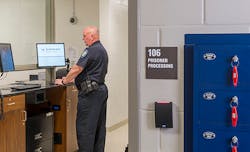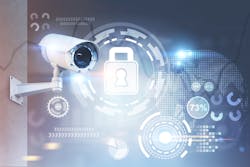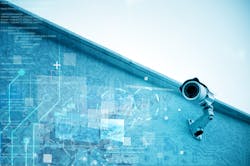The Evolution of Police Facility Design
Thirty years ago, when I designed my first police station, I remember small service windows with thick ballistic glass that distorted the view. I remember bulky cameras with clunky brackets connected with coaxial cable. Exterior cameras were even bulkier in their temperature-controlled housings. Dispatch center would have bulky CCTV control units with their own mouse or joystick and large monitors. I remember debating which doors would get access controls and which ones would not as we balanced the high cost of hardware, installation and head-end systems. But mostly, as an architect, I remember the challenge of creating an appropriate atmosphere for departments to service their community when faced with these clunky, institutional looking devices.
Today, things are much different. The technology around security and surveillance systems is much more powerful and more discreet and advancements in materials technology have changed the character of secure interior design.
For the design of new police facilities, we integrate up-to-date surveillance and access control systems that offer increased security, greater flexibility, robust technical options and durability against technological change. The surveillance systems for new stations utilizes IP-based cameras that are networked so users have the flexibility of providing, or limiting, access to any computer on the network. The image quality of both cameras and monitors have increased dramatically, allowing more flexibility in handling multiple surveillance images on a monitor or getting more detail when you pull up a single image for closer inspection.
In many cases, enhanced features are software based and exist in the head-end equipment rather than in the individual camera. Features such as facial or license plate recognition are software based. Recently manufacturers are offering software-based solutions to address the pandemic by offering temperature scanning, occupancy count monitoring, social distance monitoring and face mask compliance identification, and since it is software based, it can be added to existing systems without changing out cameras.
There are some valuable features that do require additional hardware at the camera, but the enhanced capability may be well worth the investment. Optical zoom features that are more powerful than the digital zoom on most cameras may be a choice when you want to observe small details at a great distance. On a recent police station project, we mounted such a camera aimed at a primary intersection that has been very useful in identifying more than just traffic violations. Cameras with infra-red lighting can offer visibility even under very low light situations and 360-degree fisheyes can give a view all the way around the camera. Since most cameras are plug and play with a CAT 6 connection. If you do not get these options at the outset, upgrading is much simpler.
When synchronized audio and video recording is required, such as in an interview room or at booking, these time-stamped files can be stored on a separate server for simplified back-up and greater storage capacity. The video recording camera used in conjunction with the regular security monitoring camera can provide multiple viewpoints of the same interaction. In some cases, your body and cruiser cameras can upload wirelessly so that all these recordings can be accessed with the same video management software.
Access control software has evolved over the years as well. Though the reader devices appear like the ones I specified at the onset of my career, the technology has improved. First and foremost, the encryption technology improvements have made counterfeit credentials more difficult to fabricate. Multi-factor credentials have improved, and costs have reduced over time as well. So, if you want to meet CALEA standards for drugs, weapons and valuables, or just provide increased security around the prisoner handling area, two-factor authentication can help. The two factors could be cards, pins or biometrics.
The power of access control is in the reporting. The system creates a record of every individual who accesses a door with a time and date stamp. This means that using access control readers to establish a record for cell checks is easily achieved. It will also enhance your chain of custody controls for evidentiary materials and it enables the creation of mantraps. The system will also let you know if a door is propped and left open.The real power though comes by integrating the two systems together. piggybacking can be a common hack to access control systems. This is when one person accesses the door legitimately with a credential, then a second individual grabs the door just before closing. Integrating a camera to the access system can allow you to hi-light an authorized access and observe the piggyback. Once again for access to evidentiary storage, you can have a recording if one individual uses a credential while another tags along.
So, how do assess if its time for a new security or surveillance system?
- Is your access control system a key?
- Do you have camera blind spots?
- Does your access control provide reporting features?
- Does your surveillance system offer software upgrades to enhance capabilities?
- Do you have the flexibility to allow monitoring from any computer on the network?
- Do you have sufficient storage for video footage?
When you decide to upgrade your systems there are a few things you should keep in mind. The head end system is key. The software and the server equipment provide the horsepower to offer options and extend the viability over time. If you invest well in this equipment, you can extend the lifecycle of the overall system. Be aware that you may need to consider a licensing fee to be sure you have access to software upgrades and enhancements over time. Be certain that you buy from a reputable manufacturer so that hardware support will continue long after your specific camera model has been discontinued. Also be aware of the 2019 National Defense Authorization Act that bans certain manufacturers that could introduce security risks. Be certain that your installer/integrator knows how to work with both systems to get the most capability out of the combined security network.
According to Moore’s Law, the processing power of computers doubles every two years while computers get less costly. Some Tech Industry experts say that Moore’s Law is slowing down or even dead. But regardless, it does seem likely that software enhancements s will continue to give your security and surveillance systems increased capabilities for years to come.
About the Author
Jeff McElravy, AIA, Principal, Tecton Architects
AIA, Principal, Tecton Architects
Jeff has dedicated his 34-year career exclusively to architecture for public safety facilities. As a nationally recognized expert in police station design, he serves as a planning and design consultant for departments across the country. For over 20 years, Jeff has been integrally involved in contemporary policing issues as an active member of the IACP Community Policing Committee and Annual Community Policing Award Subcommittee. A Principal at Tecton Architects and the Director of Public Safety Design, he is personally at the helm of every public safety project at the firm.



